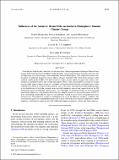Influences of the Antarctic Ozone Hole on Southern Hemispheric Summer Climate Change
Author(s)
Bandoro, Justin; Solomon, Susan; Donohoe, Aaron; Thompson, David W. J.; Santer, Benjamin D.
DownloadBandoro-2014-Influences of the An.pdf (6.649Mb)
PUBLISHER_POLICY
Publisher Policy
Article is made available in accordance with the publisher's policy and may be subject to US copyright law. Please refer to the publisher's site for terms of use.
Terms of use
Metadata
Show full item recordAbstract
Over the past three decades, Antarctic surface climate has undergone pronounced changes. Many of these changes have been linked to stratospheric ozone depletion. Here linkages between Antarctic ozone loss, the accompanying circulation changes, and summertime Southern Hemisphere (SH) midlatitude surface temperatures are explored. Long-term surface climate changes associated with ozone-driven changes in the southern annular mode (SAM) at SH midlatitudes in summer are not annular in appearance owing to differences in regional circulation and precipitation impacts. Both station and reanalysis data indicate a trend toward cooler summer temperatures over southeast and south-central Australia and inland areas of the southern tip of Africa. It is also found that since the onset of the ozone hole, there have been significant shifts in the distributions of both the seasonal mean and daily maximum summertime temperatures in the SH midlatitude regions between high and low ozone years. Unusually hot summer extremes are associated with anomalously high ozone in the previous November, including the recent very hot austral summer of 2012/13. If the relationship found in the past three decades continues to hold, the level of late springtime ozone over Antarctica has the potential to be part of a useful predictor set for the following summer’s conditions. The results herein suggest that skillful predictions may be feasible for both the mean seasonal temperature and the frequency of extreme hot events in some SH midlatitude regions of Australia, Africa, and South America.
Date issued
2014-12Department
Massachusetts Institute of Technology. Department of Earth, Atmospheric, and Planetary SciencesJournal
Journal of Climate
Publisher
American Meteorological Society
Citation
Bandoro, Justin, Susan Solomon, Aaron Donohoe, David W. J. Thompson, and Benjamin D. Santer. “Influences of the Antarctic Ozone Hole on Southern Hemispheric Summer Climate Change.” J. Climate 27, no. 16 (August 2014): 6245–6264. © 2014 American Meteorological Society
Version: Final published version
ISSN
0894-8755
1520-0442